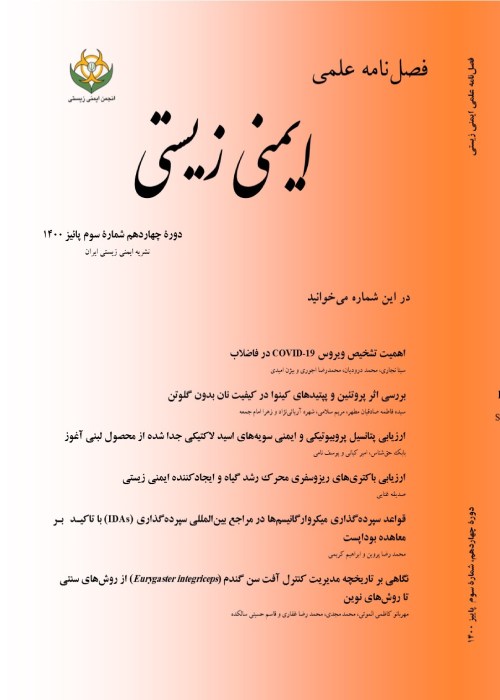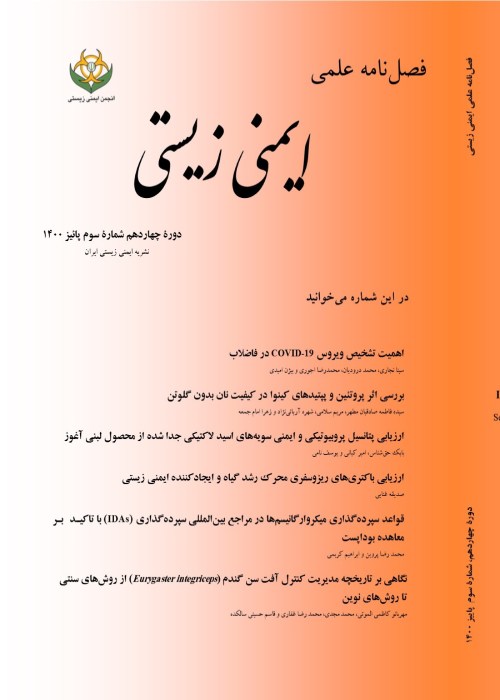فهرست مطالب

فصلنامه ایمنی زیستی
سال پانزدهم شماره 3 (پاییز 1401)
- تاریخ انتشار: 1402/05/22
- تعداد عناوین: 6
-
-
بررسی تاثیر سایبان بر برخی ویژگی های کیفی انگور بیدانه سفید و بیدانه قرمزصفحات 1-14
یکی از روش های محیط های کنترل شده در باغبانی در برابر تنش های زنده و غیرزنده، استفاده از سایبان ها است. استفاده از سایبان برای کاهش آسیب این تنش ها می تواند باعث تغییر خردقلیم گیاه و در پی آن، کیفیت محصول نهایی شود. هدف از این مطالعه بررسی اثرات سایبان بر کیفیت انگور بود. درختان انگور به مدت دو سال از اسفند تا شهریور در معرض سایبان سبز رنگ قرار گرفتند. در سال اول آزمایش، توری با سایه اندازی 50 درصد برای رقم انگور بیدانه سفید استفاده شد و نتایج نشان داد که این درصد سایه باعث کاهش کیفیت نهایی میوه می شود. در سال دوم آزمایش از توری با 20 درصد سایه اندازی برای ارقام بیدانه سفید و بیدانه قرمز استفاده شد. نتایج نشان داد که سایه اندازی 20 درصد باعث بهبود خصوصیات فیزیکی میوه به ویژه در انگور رقم بیدانه سفید شد. مواد جامد محلول، اسید قابل تیتر و ویتامین ث هر دو رقم انگور تحت تاثیر سایبان 20 درصد قرار نگرفت. فنل کل و ظرفیت آنتی اکسیدانی در سایبان 20 درصد سایه در هر دو رقم انگور کاهش یافت. به منظور توسعه فناوری سایبان برای محصولات باغبانی در کشور، تحقیقات بیشتری برای سایبان های با درصد سایه اندازی مختلف روی محصولات و ارقام مختلف در هر اقلیم ضروری به نظر می رسد.
کلیدواژگان: انگور، خرداقلیم، کیفیت، کشت های حفاظت شده، سایبان -
بررسی ترکیبات شیمیایی و خواص ضد میکروبی اسانس گیاه Malabaila secacul جمع آوری شده از استان فارسصفحه 2
-
مرورری بر رویکردهای دستیابی به بیشینه بهره وری تولید مناکینون از باسیلوس سوبتلیسصفحه 3
-
معرفی کاربرد باکتری های پروبیوتیک برای حفظ کیفیت فیله آبزیانصفحات 15-36
ماهی به دلیل رشد سریع میکروب های فلور طبیعی یا در اثر آلودگی ثانویه به سرعت فاسد می شود. در این راستا نگهدارنده های مصنوعی به طور گسترده برای افزایش عمر مفید، حفظ کیفیت و ایمنی آن استفاده می شوند. با این حال، اولویت مصرف کننده برای نگهدارنده های طبیعی و نگرانی در مورد ایمنی نگهدارنده های مصنوعی، صنایع غذایی را به جستجوی نگهدارنده های طبیعی واداشته است. نگهداری زیستی ابزاری قدرتمند و طبیعی برای افزایش ماندگاری و ایمنی غذاها با استفاده از میکروارگانیسم های طبیعی یا ترکیبات ضد باکتریایی آن ها است. در این زمینه، باکتری های اسید لاکتیک پتانسیل عمده ای را برای کاربرد به عنوان نگهدارنده زیستی نشان داده اند. اکثر باکتری های این گروه ایمن شناخته شده و پروبیوتیک هستند که به عنوان مکمل های غذایی توسط انسان مصرف می شوند. از ویژگی های باکتری های اسید لاکتیک خواص آنتاگونیستی و بازدارندگی آنها است که تحت تاثیر عوامل مختلفی مانند رقابت برای مواد مغذی و تولید متابولیت های ضد میکروبی از جمله اسیدهای آلی (به طور عمده اسید لاکتیک و استیک)، پراکسید هیدروژن و پپتیدهای ضد میکروبی (باکتریوسین) اتفاق می افتد. به نظر می رسد حفظ کیفیت غذاهای دریایی توسط باکتری های پروبیوتیک به خواص آنتی اکسیدانی آنها نیز مرتبط باشد. این بررسی به جنبه های مختلف مربوط به حفظ کیفیت غذاهای دریایی توسط باکتری های اسید لاکتیک می پردازد.
کلیدواژگان: باکتری های پروبیوتیک، نگهدارند زیستی، فیله آبزیان، نگهدارنده های طبیعی -
بررسی ایمنی استفاده از باکتریوفاژها در درمان و کنترل زیستیصفحات 53-64
باکتریوفاژها ویروس هایی هستند که به صورت اختصاصی باکتری ها را مورد هدف قرار می دهند. با توجه به فراوانی گسترده آنها در طبیعت و جداسازی آسان از محیط های مختلف و همچنین نگرانی در مورد مقاومت به آنتی بیوتیک ها، به تازگی توجه زیادی به استفاده از باکتریوفاژها برای درمان عفونت های باکتریایی شده است. همچنین مطالعات زیادی در مورد کاربرد و استفاده از باکتریوفاژها در صنایع مختلف از جمله صنایع غذایی انجام گرفته است. اما قبل از استفاده و کاربردی کردن استفاده از فاژها لازم است ایمن و بدون ضرر بودن آنها اثبات شود و در صورت نیاز الزامات قانونی لازم برای استفاده از آنها تعیین شود. در حالی که در مطالعات فاژ درمانی به طور کلی تا به امروز ایمن اعلام شده است، اما هنوز درک جامعی از تعاملات بین فاژ و میزبان انسانی وجود ندارد.
کلیدواژگان: باکتریوفاژ، سمیت، عوامل ایمن، فاژ درمانی، کنترل زیستی -
مروری بر اهمیت و مسیر تجاری سازی فرآورده های بیوکنترل میکروبی کشاورزی در ایرانصفحات 65-78
آگاهی عمومی از اثرات سوء و بلند مدت سموم شیمیایی دفع آفات نباتی منجر به استقبال و کاربرد روش های کم خطر برای انسان و محیط زیست شده است. در سال های اخیر، راهکارهای جایگزینی مانند کنترل زیستی به عنوان رویکردی کم خطر و پایدار برای مدیریت بیماری ها و آفات گیاهی مورد توجه قرار گرفته است. تولید عوامل بیوکنترل آفات کشاورزی در هر کشور طبق قوانین و دستورالعمل های سازمان های کشاورزی، محیط زیست و غذا و دارو در آن کشور انجام شده و حسب قواعد خاص طی مراحل مختلف پس از اخذ مجوز تجاری سازی می شوند. در ایران اجرا و نظارت بر قوانین مربوط به تولید فرآورده های بیوکنترل در کشاورزی، تحت نظر سازمان حفظ نباتات و همکاری چند سازمان دیگر انجام می شود. در این مقاله، به اختصار مروری بر اهمیت استفاده از عوامل بیوکنترل در کشاورزی و مراحل اخذ مجوز و تولید و چگونگی عرضه آنها به بازارهای داخلی آورده شده است.
کلیدواژگان: آفت کش های میکروبی، بیماری های گیاهی، تجاری سازی، سموم شیمیایی، فرآورده های بیوکنترل
-
Effect of Shading Cover on some Quality Properties of ‘Bidaneh Sefid’ and ‘Bidaneh Ghermez’ GrapesPages 1-14
One protected horticultural method against biotic and abiotic stresses is shading covers. Using shading cover to reduce the damage of this stress can change the plant's microclimate and, subsequently, the final product's quality. This study aimed to investigate the effects of shading cover on grape quality. The grapevines were subjected to shading cover cloth with green color from March to September for two years. In the first year of the experiment, a shading cover with 50% shade was used for Bidaneh Sefid grape variety, and the result indicated that this percentage of shade reduced the final fruit quality. In the second year of the experiment, 20% shade was used for Bidaneh Sefid and Bidaneh Ghermez varieties. Results showed that this shading percentage improved the physical properties of the fruit, especially in the Bidaneh Sefid variety. Soluble solid content, titratable acid, and vitamin C of both grape varieties were not affected by 20% shade. Like 50% shade, total phenol and antioxidant capacity were decreased by 20% shade in both grape varieties. Further research for different shade percentages on different crops and cultivars in every climate will be necessary to develop shading cover technology for horticulture crops in Iran.
Keywords: Grape, Quality, Shading net, Microclimate, Protected horticulture -
Evaluation of chemical constituents and antimicrobial properties of the essential oil from Malabaila secacul, collected from Fars provincePage 2
-
A review of the strategy to attain the maximum productivity of menaquinone production from Bacillus subtilisPage 3
-
Introducing the Application of Probiotic Bacteria to Maintain the Quality of Aquatic FilletsPages 15-36
Fish is extremely perishable as a result of rapid microbial growth naturally present in fish or from contamination. Synthetic preservatives are widely used in fish storage to extend shelf life and maintain quality and safety. However, consumer preferences for natural preservatives and concerns about the safety of synthetic preservatives have prompted the food industry to search for natural preservatives. Most bacteria in this group are known to be safe and probiotics are consumed by humans as dietary supplements. The antagonistic and inhibitory properties of lactic acid bacteria are due to different factors such as the competition for nutrients and the production of antimicrobial metabolites such as organic acids (prevailingly lactic and acetic acid), hydrogen peroxide, and antimicrobial peptides (bacteriocins). It seems that maintaining the quality of seafood by probiotic bacteria is also related to their antioxidant properties. This review deals with various aspects related to maintaining the quality of seafood by lactic acid bacteria.
Keywords: Aquatic Fillets, Biological Preservative, Natural Preservatives, Probiotic Bacteria -
Safety investigation of the use of bacteriophages in treatment and biological controlPages 53-64
Bacteriophages are viruses that specifically target bacteria. Due to their wide abundance in nature and easy isolation from different environments, as well as concern about antibiotic resistance, recently there has been a great interest in using bacteriophages in the treatment of bacterial infections. Also, many studies have been conducted on the application and use of bacteriophages in various industries, including the food industry. However, before using phages, it is necessary to prove that they are safe and harmless, and if necessary, determine the legal requirements for their use. While to date studies of phage therapy have generally been shown to be safe, still, there isn’t a comprehensive understanding of the interactions between phage and the human host.
Keywords: Bacteriophage, Immune Factors, Toxicity, Phage therapy, Biocontrol -
An overview of the importance and path of commercialization of agricultural microbial biocontrol products in IranPages 65-78
Awareness of the long-term adverse effects of chemical pesticides has led to the use and acceptance of less harmful approaches and alternative applications such as biological methods as promising and sustainable methods for managing plant diseases and pests. The production of agricultural biocontrol agents in each country is carried out according to the laws and instructions of the agricultural organizations of that country and enters the market according to specific rules and through different stages to obtain a license. In Iran, the implementation and monitoring of the laws related to the production of agricultural biocontrol products are carried out under the supervision of the Plant Protection Organization and the cooperation of several other organizations. In this article, an overview of the importance of using biocontrol agents in the agricultural sector and the stages of obtaining a license and production and how to supply to domestic markets is given.
Keywords: microbial pesticides, plant diseases, commercialization, chemical toxins, biocontrol products


